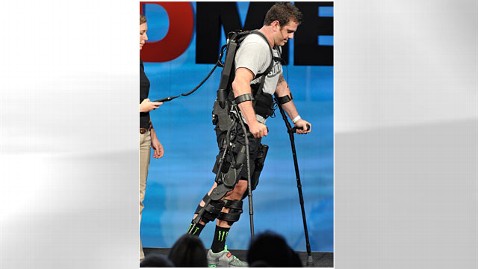Spinal Cord Shock Helps Paraplegic Move Legs

Gitika Ahuja, a producer for ABC News’ Medical Unit, is at TEDMED2011, a conference that can best be described as an explosion of ideas and innovation, where curious minds in medicine, technology and everything in between come together to share and inspire. She will be blogging this week about the latest and greatest talks, technologies and stories.
I just heard two incredible stories of movement that I can’t wait to share with you. Why? It’s really quite incredible to see a paraplegic walk. It’s a beautiful thing when the impossible becomes possible, when a big NO turns into a big YES. When most spinal cord injury patients ask the question, “Will I be able to walk again?” this is what they usually hear: “No. No. No.” Well I’m not so sure that will always be the answer after hearing Eythor Bender, CEO of Esko Bionics, speak. His company makes engine-powered, wearable robots called “exoskeletons” that allow a paralyzed person to walk again– just by slipping the device on like a pair of jeans. It’s just as cool as it sounds.
To prove it, Paul, a paraplegic, rolled onto the stage — in his wheelchair, but seated, wearing an exoskeleton. And then, with the help of one of the designers, he stood up. He stood up and walked across the stage on his own. He said he had only worn the robot a half-dozen times but that he was not afraid to fall.
Not only was he not afraid, he was looking forward to one thing, he said: ” Sorry ladies, but I would like to pee standing up.” Can’t blame him. The wheelchair is 1,500 years old. Bender says there are 70 million people in wheelchairs worldwide. Paul said he too once took walking for granted, but now he is hopeful that robots like this could replace the old wheelchair for him and many others. (By the way, I hear there are others out there like this coming on the market, too).
These are no longer ideas of the future — they are here. The exoskeleton is now being used in rehabilitation centers. By the middle of next year, the company expects it will be available for monitored home use and then a couple years after that in 2014, it should be available for person use. The cost? Bender says it will be in the range of other prosthetics at $30-50K.
And then Andrew Dawson took the stage, a former director, dancer, mime and hand model. He admits his utter fascination with hands, especially with those that are impaired in some way. He showed us (and by show– I mean he acted it out with his hands) the story of Debbie Gray, a 23-year-old diver who broke her neck and suffered a spinal cord injury when a dive went wrong and she hit the bottom of the pool. She floated to the surface, her friends rescued her, but today she is a quadriplegic and will be in a wheelchair for the rest of her life.
But now, the incredible part of her story– she is now experiencing movement with a “bionic” surgical implant– electrodes in her arm and hands– called the “free hand system.” There are wires, receivers, coils but mainly electrodes on her muscles that are connected to a computer on her chair. If she moves her left shoulder back, it opens her right hand. If she moves her right shoulder forward, it closes her left hand. Dawson tells us the story on stage, as Debbie’s audio rings over the air… she says, “I can feed myself now.” She can hold a fork, though Dawson tells us she gets an electric shock in her mouth when she eats potatoes but not carrots. Debbie, a quadriplegic, can now feed herself, brush her hair again, which means she can actually let her hair grow long again. Imagine that.